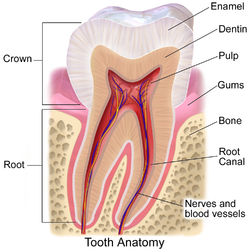Gingival
| Gums | |
|---|---|

Cross-section of a tooth with gums labeled
|
|
| Details | |
| Identifiers | |
| Latin | Gingiva |
| MeSH | A14.549.167.646.480 |
| Dorlands /Elsevier |
12390396 |
| TA |
A05.1.01.108 A03.1.03.003 A03.1.03.004 |
| FMA | 59762 |
|
Anatomical terminology
[]
|
|
The gums or gingiva (sing. and plur.: gingivae), consist of the mucosal tissue that lies over the mandible and maxilla inside the mouth. Gum health and disease can have an effect on general health.
Gingiva are part of the soft tissue lining of the mouth. They surround the teeth and provide a seal around them. Unlike the soft tissue linings of the lips and cheeks, most of the gingivae are tightly bound to the underlying bone which helps resist the friction of food passing over them. Thus when healthy, it presents an effective barrier to the barrage of periodontal insults to deeper tissue. Healthy gingiva are usually coral pink in light skinned people, but may be naturally darker with melanin pigmentation.
Changes in color, particularly increased redness, together with edema and an increased tendency to bleed, suggest an inflammation that is possibly due to the accumulation of bacterial plaque. Overall, the clinical appearance of the tissue reflects the underlying histology, both in health and disease. When the gingival tissue is not healthy, it can provide a gateway for periodontal disease to advance into the deeper tissue of the periodontium, leading to a poorer prognosis for long-term retention of the teeth. Both the type of periodontal therapy and homecare instructions given to patients by dental professionals and restorative care are based on the clinical conditions of the tissue.
The gingiva is divided anatomically into marginal, attached and interdental areas.
The marginal gingiva is the terminal edge of gingiva surrounding the teeth in collar like fashion. In about half of individuals, it is demarcated from the adjacent, attached gingiva by a shallow linear depression, the free gingival groove. This slight depression on the outer surface of the gingiva does not correspond to the depth of the gingival sulcus but instead to the apical border of the junctional epithelium. This outer groove varies in depth according to the area of the oral cavity; the groove is very prominent on mandibular anteriors and premolars.
The marginal gingiva varies in width from 0.5 to 2.0 mm from the free gingival crest to the attached gingiva. The marginal gingiva follows the scalloped pattern established by the contour of the cementoenamel junction (CEJ) of the teeth. The marginal gingiva has a more translucent appearance than the attached gingiva, yet has a similar clinical appearance, including pinkness, dullness, and firmness. In contrast, the marginal gingiva lacks the presence of stippling, and the tissue is mobile or free from the underlying tooth surface, as can be demonstrated with a periodontal probe. The marginal gingiva is stabilized by the gingival fibers that have no bony support. The gingival margin, or free gingival crest, at the most superficial part of the marginal gingiva, is also easily seen clinically, and its location should be recorded on a patient’s chart.
...
Wikipedia
